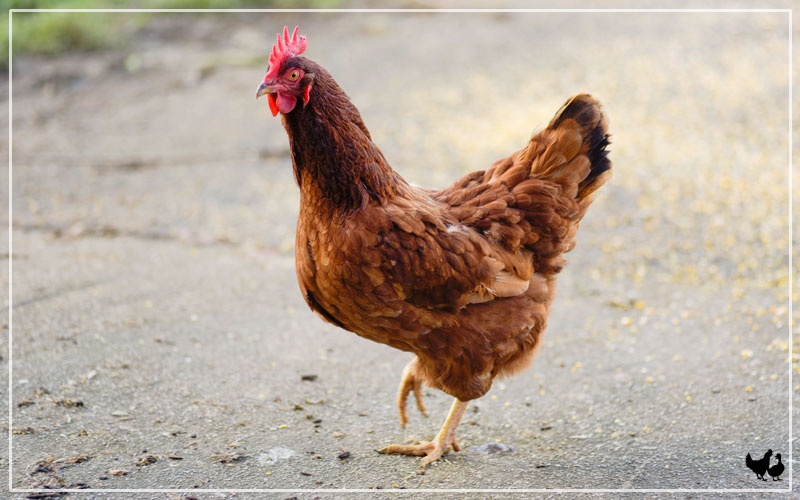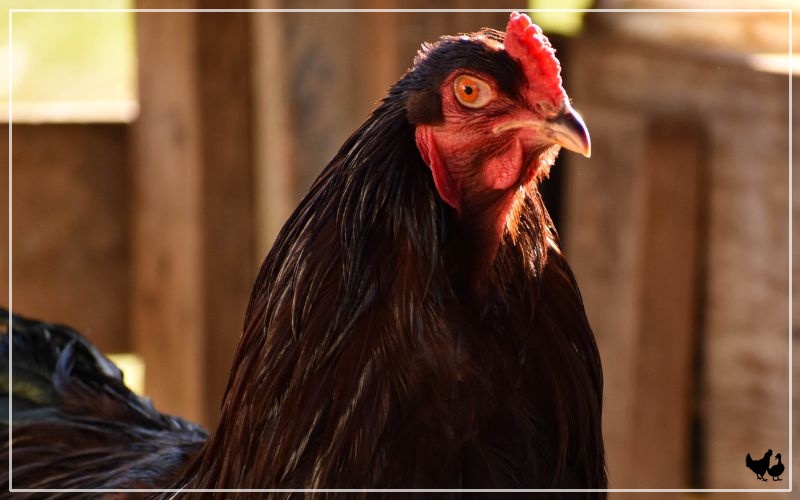10 Red Chicken Breeds
Red is a vibrant color associated with courage, danger, life, and health. It also signifies strong emotions like fear and love. Regardless of your perception, no one can deny its beauty and noticeability.

If your flock mostly consists of black and white birds, here are ten red chicken breeds you might want to consider.
1. Rhode Island Red

The Rhode Island Red is one of the most successful chicken breeds worldwide. Since its inception in America’s Rhode Island, it has spread to other countries breeding and replication in large numbers. The primary reasons behind its success are adaptability to different climates and robust immunity against common poultry diseases.
In 1854, farmers in the New England region developed this breed. The main focus was to create a utilitarian dual-purpose breed without emphasis on appearance. Rhode Island chickens look like elongated brings, with a rectangular, plump body. Their plumage isn’t pure red – it ranges from dark rusty brown to rich mahogany red.
Rhode Island chickens are fairly large, with roosters averaging at 8.5 lbs. and hens at 6.5 lbs. Hens start producing eggs as early as 16 weeks from hatching, laying five to six eggs weekly. Over 12 months, they can produce between 200 and 300 eggs. The light-brown eggs get bigger as the hen ages.
Like most chickens, Rhode Islands are docile. However, roosters can become aggressive during the mating season.
2. New Hampshire Red

The New Hampshire Red breed is a derivative of the Rhode Island Red, meaning it shares many characteristics with its parent. After years of selective breeding, the New Hampshire has become an independent breed.
The most significant difference between the New Hampshire Red and the Rhode Island Red is the former produces more meat. However, more meat translates to fewer eggs. Additionally, New Hampshire matures faster.
Like the Rhode Island breed, New Hampshire is large and averages between seven and eight pounds for mature birds. Its egg production is fair, averaging three brown eggs weekly.
Regarding temperament, New Hampshire chickens are docile and hens are good brooders. The birds respond well to confinement but can become aggressive if provoked.
3. Welsummer Chicken

Welsummer chickens are a fairly new breed developed in the Dutch town of Welsum. Despite its newness, it is gaining traction among poultry farmers worldwide. Its creators aimed to create a bird resembling a partridge, and they crossed patridge varieties like Cochin, Leghorn and Wyandotte. The result was a medium-sized, dual-purpose breed.
Although Welsummers are dual-purpose birds, they’re lighter than most broilers. Roosters average seven pounds, while hens are a pound lighter. Nonetheless, the birds appear compact since they have well-built bodies despite being tiny.
Welsummer chickens are docile and friendly to other breeds and human beings. They always prefer foraging to picking fights.
4. Red Star Chicken

Red Star chickens are a hybrid breed kept for laying eggs. Because they’re a crossbreed, physical characteristics are inconsistent and vary from one bird to another. Generally, it is a medium-sized breed with an average weight ranging between six and seven pounds.
Most Red Star chickens have a light-brown plumage with a tinge of red. Some have a few black feathers around the tail. The birds have fairly small wattles and red earlobes, with yellow or brown beaks. They have a single comb, making them susceptible to frostbite and other complications caused by extreme temperatures.
Each Red Star chicken has a unique temperament. Again, this is because they’re a hybrid. Some poultry farmers describe them as docile and friendly, while others say they’re aggressive and raucous.
Red Stars love foraging and excel when confined in large spaces. Despite this behavior, they respond well to confinement in small rooms. Due to their flighty nature, it’s advisable to erect high fences when confining these birds.
5. Red Silkie Chicken

If you want a feathery, friendly pet chicken for you and your kids, the Red Silkie breed is an ideal choice. These birds are as cuddly, friendly and happy as they look. However, these chickens aren’t suitable for every climate.
Traditional Chinese legends state that Silkie birds have medicinal value. This belief is true, as studies show that their meat contains carnosine, a vital antioxidant that boosts immunity and helps to prevent diseases.
Silkies bodies are covered with distinctive downy feathers that many mistake for fur. This cover is mostly white, but some birds have black, blue, gold, and gray plumage. The face and skin are black, while the beak is usually gray.
Red Silkie chickens are a small breed, averaging three to four pounds. Americans recognize them as a bantam breed.
Despite having a ‘furry’ skin, Silkie don’t thrive in cold climates. If you live in a cold and humid environment, it’s best to avoid keeping this breed.
Silkies are gentele birds that like cuddling with human beings. They love human attention so much that they chatter as they follow you around. Hens have strong maternal instincts and never let go chicks until maturity.
6. Buckeye Chicken

Buckeye is a beautiful dual-purpose chicken renowned for its hardiness. It originates from wild birds, giving it a good blend of brooding, foraging, and hunting instincts. Regardless, it is docile and has strong immunity, making it a useful addition to your poultry farm.
Buckeye chickens are named after the Buckeye State in Ohio. It’s the only breed developed entirely by a female scientist. As mentioned above, it’s a cross of several game and domestic birds, including Buff Cochins, Barred Plymouth Rock, and Black-breasted Red Game.
The Buckeye has a distinctive body shape with slanted meaty thighs and muscular breasts and wings. Its plumage is slightly darker than the Rhode Island’s. Due to its game bird origins, it has tight feathering and a black-tipped tail.
Roosters are large and heavy, averaging nine pounds. On the other hand, hens weigh between six and seven pounds when mature.
Regarding temperament, Buckeyes are docile and inquisitive birds that act friendly to humans. Despite their size, they rarely bully smaller birds. They have excellent foraging skills and flourish when allowed to roam freely.
7. Red Shaver Chicken

Red Shaver Chicken is a dual-purpose breed native to Canada. It’s developers targeted small-scale poultry farmers rather than large-scale farmers. You can visually separate these chickens after hatching or within a few weeks after birth because it’s a sex linked breed.
Red Shavers are attractive, with a red single comb. Roosters tend to have larger combs than hens. They also weigh more, averaging six pounds while females average five pounds. Both sexes have yellow, featherless legs.
Hens are excellent layers, and can produce between 300 and 320 eggs yearly. The eggs are large and brown. They also produce a decent amount of meat.
8. Red Leghorn

Leghorn is primarily an egg-laying breed originating from the Tuscany region in Italy. The Red Leghorn is its derivative, and it’s rare. It features a vibrant red plumage with white earlobes and yellow, featherless legs. Chicks are reddish-brown with occasional dark specks and markings on the back.
Upon maturity, roosters weigh six pounds while hens weigh five pounds. The hen is an average layer, producing 150 to 200 white, medium-sized eggs annually. However, their meat production is appalling.
Red Leghorns are fairly hardy. They can withstand extreme heat and survive mild winters. However, they become susceptible to frostbite when it starts to freeze.
Female birds are poor brooders and relatively uncaring mothers. Overall, the breed is docile.
9. Derbyshire Redcap

Derbyshire Redcap is a chicken bred native to the Derbyshire county in Central England. The name ‘Redcap’ signifies the bird’s distinctive large comb that resembles a rose.
Redcaps are a large-sized breed, with cockerels weighing eight pounds and hens seven pounds. The standout differences between them and similar-looking breeds are the enlarged comb and red earlobes. All birds have a single plumage type, with several shades of red, black and brown. Males have a broader color variation, but both sexes have black tails.
Derbyshire Redcaps are a hardy breed that flourish in free range conditions. They are suitable for egg and meat production, and their beauty makes them a valuable ornamental asset.
10. Red Pekin Chicken

All Pekin chickens are bantams, with males weighing 680 grams and females 570 g. They have short, feathered legs. The plumage extends to the feet and toes. Red Pekins have a full and rounded tail (called a bustle) that makes them puffed and rounded.
When mature, hens lay between 120 and 160 small, white eggs yearly. These birds have excellent mothering instincts and take care of chicks until they can find food independently.
Due to their tiny size, it’s advisable to keep Pekins in confinement. Their stature makes them defenseless against potential predators and larger breeds.
Conclusion
Keeping one chicken breed is boring. If your current flock is predominantly white or brown, consider adding any of the red chicken breeds listed above, as they are suitable for meat, eggs, and ornamental purposes.
However, you can’t reap benefits from your poultry farm if you don’t take care of your chicken. Ensure they get adequate food and water, keep their coop clean, and vaccinate them in time.



